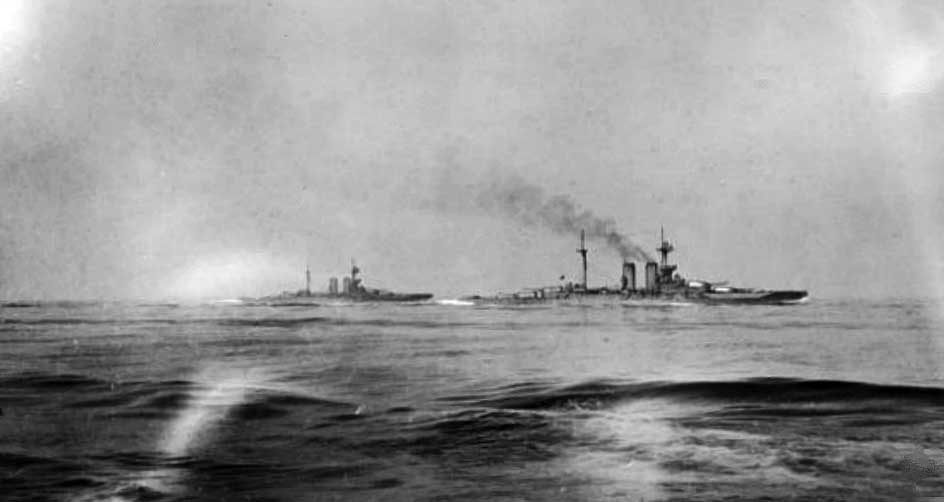Battle of Jutland Island

HMS Warspite and Malaya, seen from HMS Valiant at around 14:00 hrs
This battle, in the North Sea, was the only naval battle of the war in which the main German and British fleets engaged each other. Previously and subsequently, the naval war was a series skirmishes with German raiders and submarines. The British were successful in blockading the Germans, while the Germans were successful in blocking aid to the Russians and sinking a large number of British merchant vessels with submarines. The battle itself was a tactical victory for the Germans, who sunk twice as much tonnage as the British. The results did not change the strategic situation, however, and the Germans resorted to unrestricted submarine warfare that ultimately resulted in the US intervention.
The Battle of Jutland Island was the only major naval fleet battle of World War I and the last major naval battle that battleships were the main capital ship.
The British Navy with its 28 battleships compared to the 16 that the Germans had maintain an overwhelming advantage over the Germans, so an all out battle between the two navies was never an option for the German Navy. Instead the German naval strategy was to try to obtain a tactical advantage by surprising smaller number of British ships which they could defeat in limited engagements. The Germans also relied on their submarines which they felt could surprise British battleships and thus even the odds.
The German plan was to send out a group of battlecruiser to attack British shipping and thus to draw out a part of the British fleet. The British who had obtained a copy of the German code book were aware of the plans and moved to counter it. On May 30, 1916 the British moved a fleet of 16 battleships and 3 battlecruisers from England to a point off the coast of Norway. They were joined by an additional fleet squadron of 8 battleships that were already at sea.
The German fleet sortied early in the morning of the May 31st.
As the battle shaped up the British had a clear advantage:
| British | German |
|
|---|---|---|
| Dreadnought battleships |
28 | 16 |
| Pre-dreadnoughts | 0 | 6 |
| Battlecruisers | 9 | 5 |
| Armoured cruisers | 8 | 0 |
| Light cruisers | 26 | 11 |
| Destroyers | 79 | 61 |
| Seaplane carrier | 1 | 0 |
In throw power the advantage was clear the combined British force could fire a total broadside of 332,360 lbs compared to the German 132,116. The German hoped that their ships which they thought better designed and with better training could carry the day
As the battle began the German with the German battle cruisers engage the vanguard of the British fleet maneuvering them so that they found themselves engaged with the main german fleet. The Germans had the upper hand in that encounter. The British however, managed to turn the table when they drew the German fleet to follow the British warships Northward right into the path of the Main British fleet. The Germans had not been aware that the Main Fleet was there and the suddenly found themselves in the middle of what may have been the largest gun encounter in history. The Germans successfully disengaged before the British could do too much damage. The British tried to cut off the German fleet from its base, but the Germans managed to slip through their lines.
To this day historians argue about who won the battle. The general consensus was the battle was a draw. It was a tactical victory for the Germans who sunk more ships 15 British ships with combined tonnage of 113,300 as opposed to the British who sunk 12 ships with a total tonnage of 62,300. The British lost 6,748 sailors and the Germans 3,039. Despite this fact strategically it was a partial victory for the British. The German navy could not sustain the losses it had suffered being much smaller, and when faced with the main British fleet the Germans were forced to withdraw. On the hand the British navy, massed with overwhelming force was unable to destroy the German navy. After the battle the Germans decided to return to all out submarine warfare, a decision that led to the American intervention in the war.
 >
>